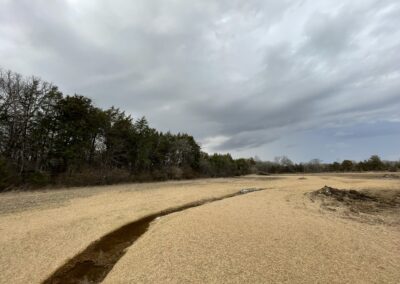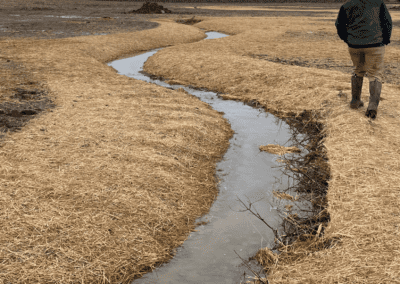bridging gaps in land investing and conservation through mitigation banking
Contact us
About Clearwater Conservation Revival

CCR was established in 2021 with the goal of bridging gaps in land investing and conservation through mitigation banking. CCR is a woman-owned business which aims to provide compensatory mitigation for impacts to wetlands and streams occurring from site development and infrastructure growth. CCR’s investments start with the acquisition of degraded land considered to be of low ecological resource value and depleted biodiversity. CCR’s team of ecologists, biologists, soil scientists, stream restoration engineers, and construction engineers work together to transform these lands into rich, thriving, and diverse ecosystems generating environmental credits for purchase. CCR is also a Design/ Build company, which utilizes a turnkey (“cradle to grave”) mitigation approach to all our projects.
Our Services
CCR’s Design/Build approach to projects typically incorporates the following:
Service Area (Market) Analysis
One of the most important steps in developing a good mitigation project or Bank site is identifying a viable market. So, what makes a good market?
First, it’s important to understand what defines a mitigation market, or service area, as mitigation professionals typically refer to it. The service area is typically defined as the geographical area in which compensatory mitigation can be developed and used to offset the aquatic resource functions lost through actions permitted under §404 of the Clean Water Act.
Generally speaking, the primary service area is established as the 8-Digit Hydrologic Unit Code (HUC) watershed. The primary service area may also be partially defined by having a similar ecoregion. In most cases, a secondary service area is established and consists of one to two directly abutting 8-Digit HUCs.
Site Selection and Feasibility Analysis
With the passage of the federal government’s historic infrastructure bill in 2021, the need for wetland and stream mitigation is more important than ever to municipal, energy, transportation, and commercial development projects. And as land suitable for mitigation becomes more costly and less available, reliable site selection/feasibility studies are absolutely critical before investing in a mitigation project.
Selecting an appropriate site to develop wetland and/or stream mitigation is the first and likely the most critical element to developing a successful mitigation project or Bank site. Numerous factors should be considered and analyzed prior to selecting a site for development. Feasibility studies, including desktop reviews for soils, hydrology, land use, the existence of utilities, easements, and other encumbrances, water rights, zoning, and other general site constraints need to first be completed. Following desktop reviews, site due diligence studies, including the evaluation of existing natural communities and water resources, are essential for determining a site’s overall feasibility.
DRONE SURVEYS
CCR’s drone services are provided by Zach Wilbanks, an FAA certified drone pilot. CCR can provide a wide variety of site assessment and survey data including:
● Aerial Imagery & Photographs
● Geo-referenced Orthomosaic Rasters
● Topographic Surveys
● Stockpile Volume Estimates
● Pit Progress Mapping
● Drainage Pattern Delineation
● Wetland Delineation Support
● Stream Planform Delineation
● Floodplain modeling
● Vegetation Delineation
● Volumetric Surveys
● Mill Wood Stock Volume Estimates
● Drained Pond and Harbor Dredging Estimates
● Airport Tree Elevation Estimates
OUTPUTS & DELIVERABLES
GeoTIFF image(s)
Contour Shapefiles and DWF Features
Point Clouds (LAS) and ASCII (TXT) files
Digital Elevation Models (DEMs)
Google Earth KMLs3-D PFDs
Mr. Wilbanks has been properly trained and has obtained all necessary certifications from the Federal Aviation Administration (FAA) to provide services using UAS. A senseFly eBee Plus RTK fixed-wing UAS is used with our services.
Environmental Baseline Studies
Whether it is a baseline study for full stream restoration design, wetland restoration site plan, or large-scale mitigation Bank, our team regularly performs these tasks to help our clients meet their project mitigation goals. CCR’s baseline studies include:
● Detailed drone topographic and LiDAR surveys
● Protected species and habitat surveys
● Wetland and stream delineations and reporting
● Hydrologic determinations
● Stream reference reach studies
● Detailed and rapid stream quantitative functional assessments
● Wetland rapid assessments
● Prior converted farmland studies
● Groundwater monitoring
● Botanical surveys
● Natural community assessments
● Comprehensive soil surveys
● Cultural Resources Survey Coordination
● Phase I Environmental Site Assessments
Prospectus Development
CCR’ team has over three decades of combined experience developing conceptual mitigation plans and prospectus documents. Developing a mitigation bank is an administrative process and the first step in this process is for the Bank sponsor to create a Mitigation Bank Prospectus. The Prospectus document includes the initial ideas and concepts at the feasibility phase. The Prospectus typically involves selecting a “Preferred” concept that may or may or may not be modified into the last phases of design and the draft Mitigation Banking Instrument (dMBI).
In some cases, a Prospectus document may involve preliminary design (i.e., beginning of the engineering efforts in developing the natural channel design plans and details of wetland restoration and reestablishment efforts. The Prospectus stage is important as it provides the opportunity for the Interagency Review Team (IRT) to review the site and concept plans early, offering early coordination that could provide critical to the success of a project. Ultimately, the development of the Prospectus should help determine potential credit yields for the stream and wetland mitigation being proposed.
Mitigation Banking Instrument Development
CCR is fully staffed and trained in all the necessary disciplines to successfully identify Bank sites, acquire the land and/or necessary conservation easements, and develop stream and wetland restoration plans, 12-part mitigation plans, Sections 404/401 permit applications, Stormwater Pollution Prevention Plans (SWPPPs), EPSC plans, and Final Mitigation Banking Instruments. Our team is also experienced in Section 106 and Section 7 coordination, both of which, may be critical to achieving a site’s final MBI and approved permits.
While CCR is a relatively young company, two of its founding members, Rhett Baggett and Zach Wilbanks, are considered leaders in the mitigation banking industry in the Southeastern US. Combined, Rhett and Zach have successfully developed and managed over 30 wetland and/or stream mitigation banks, permittee-responsible mitigation sites, and In-Lieu Fee (ILF) projects throughout multiple Corps Districts. Additionally, CCR’s majority owner, Laurel Baggett, is a licensed real estate agent and brings almost a decade’s worth of experience in real estate services and land investment strategies.
Ecosystem Restoration Design
Despite large advances in ecosystem restoration science and engineering, many practitioners in the industry still fail to achieve measurable functional lift to the aquatic and terrestrial habitat they seek to restore. While CCR’s team utilizes advanced methodologies to Natural Channel Design (NCD) and wetland restoration to our projects, we believe project success starts with our use of an ecologically holistic, watershed approach. Simply put, we work from the headwaters to downstream and consider everything within the local watershed. Before spending a single hour developing a concept design, our team first develops site specific, measurable, and realistically attainable goals for the project. We believe this approach is critical for developing a successful design plan leading to a sustainable restoration project.
Our techniques for in-stream restoration improves sediment transportation and increases aquatic habitat for the benefit of all aquatic species. Riffles are designed to increase and diversify macroinvertebrate populations as well as to create spawning habitat. Pools are designed with appropriate spacing and depth to better connect to the groundwater table to allow for species migration and survival during periods of drought. Woody debris, such as toe wood, brush mattresses, log seals, log veins, and root wads, is added for habitat diversity, and is a big part of most of our stream designs. Finally, where possible, all our natural channel designs have a strong focus on floodplain connectivity and adjacent wetland riparian communities.
Key workshops and training completed by our staff include:
● Advanced Topics in Hydric Soils
● Assessing and Restoring Headwater Mountain Streams
● Natural Channel Design Review Checklist
● Innovations in Stream and Wetland Restoration
● Level I. Applied Fluvial Geomorphology
● Level II. River Morphology and Applications
● Level III. River Assessment and Monitoring
● Level IV. River Restoration and Natural Channel Design
● TN Qualified Hydrologic Determination Course
● Wetland Hydrology Design Course, NC State University/Swamp School
● Wetland Mitigation Planning Course, NC State University/Swamp School
● Stream Classification and Assessment Course, NC State University and North Carolina
Stream Restoration Institute
● TDEC Level I Fundamentals of EPSC Certification
● Stream Restoration Construction Management Training, Stream Restoration Institute/Lake Wheeler Land Application Training and Demonstration Center
PROFESSIONAL CERTIFICATIONS AND REGISTRATIONS
● Professional Wetland Scientist (PWS)
● TN Qualified Hydrologic Professional (TN-QHP)
● TDEC Level I & II Certified Professionals
● Professional Engineers (TN, AL, MS, GA)
Construction
CCR offers a design-build approach to all our projects. One of our partners, Zach Wilbanks. is principal owner of Wilbanks Engineering & Environmental Solutions, LLC (Wilbanks), CCR turns to Wilbanks and its highly qualified team of experienced stream restoration construction engineers and operators to build and implement our mitigation projects. Our team’s extensive experience working together designing and building streams allows us to bring innovative ideas to contractors, partners, and landowners. This partnership with Wilbanks allows CCR to deliver projects with a strong emphasis on expedited schedules, cost control and quality assurance, while adding significant value by solving complex constructability issues during the design phase.
Construction Engineering Oversight
CCR uses an adaptive approach to stream and wetland restoration design and implementation of our projects. From the very start, CCR builds flexibility into the design and construction facets of all our projects. This approach eliminates over-design of stream channels and allows for the necessary field adjustments that almost always arise on any stream restoration project. Our construction oversight engineers and scientists have over three decades of combined construction oversight experience. They also have received stream restoration construction management training, from the North Carolina Stream Restoration Institute/Lake Wheeler Land Application Training and Demonstration Center and completed Rosgen Levels I through IV.
Development of As-built Plans and Report
CCR’s professional as-built surveying services provides clients with accurate ground information primarily for stream and wetland mitigation projects for post construction recording as required by the IRT. For mitigation projects, regardless of the state or Corps District, the IRT requires that the Bank Sponsor or Contractor or permittee provide an as-built survey and report once mitigation construction activities have concluded.
The as-built report includes adequate survey data to demonstrate to the IRT that all components of the mitigation Bank/project have been constructed, installed, managed, and planted according to final design plans. Any in-field adjustments made to the original design plans should also be documented and justified (should the change be considered substantial).
The primary purpose of a mitigation as-built report is to provide a baseline for comparison during future success monitoring. A sufficient as-built survey and report should include the installation of permanent monitoring stations for future geomorphic, hydrologic, vegetation, and photographic monitoring.
Post Construction Success Monitoring
All mitigation projects require annual post-construction monitoring. CCR’s staff have over 25 years’ experience managing and conducting post-construction success monitoring on Mitigation Bank, ILF Program, and permittee-responsible mitigation sites throughout Tennessee, Georgia, Alabama, Mississippi, and North Carolina. Our staffs’ experience includes monitoring more than 30 statewide mitigation sites for the Tennessee Department of Transportation, multiple projects for the North Carolina Ecosystem Enhancement Program, and over 20 private mitigation banks and/or permittee-responsible mitigation projects throughout the Southeastern US.
Learn more about our services
Purchase Wetland and Stream Credits
Currently, CCMB has sold its initial release of stream and wetland credits. However, it is anticipated that an additional 2,721.15 stream credits and 16.7 wetland credits will be available for purchase as early as April 2023. Please contact us for information on credit and retainer pricing to reserve your credits today.

CONTACT US
Projects
Christmas Creek Mitigation Bank
Over the past decade, Davidson, Rutherford, and Wilson counties have experienced tremendous economic growth, thus driving significant commercial and residential development within the Stones River Watershed. One of the indirect consequences of this growth, are impacts to the watershed’s water resources. In the summer of 2021 to help mitigate for these impacts, CCR began working with landowners in Christiana, Tennessee to develop the Christmas Creek Mitigation Bank. In the months to follow, CCR and its consultants/engineers completed numerous geomorphic, ecological, soil, and groundwater studies on three different parcels totaling 196 acres. In September 2022, CCR received approval for their final Mitigation Banking Instrument (fMBI), Section 404/401 permits and Construction General Permit (CGP) to begin construction of the Bank.
All total, approximately 150 acres of cultivated agricultural land, pasture, farmed wetlands, and over 10,352 LF of degraded stream channel has been restored back to a mosaic of wet oak savannas, bottomland hardwood forested wetlands and meandering streams. Following construction activities, the project resulted in over 12,061 LF of newly restored stream and over 147 acres of restored and enhanced wetlands. Stream and wetland restoration and enhancement efforts have resulted in significant ecological lift, initially generating 4,947.55 SQT stream credits and 122.34 wetland credits. It is estimated that the CCMB will ultimately generate over 7,500 SQT stream credits prior to site closure.
Contact Us

Laurel Baggett
Officer / Affiliate Broker

J. Rhett Baggett, PWS, TN-QHP
President, Principal Owner/Senior Ecologist



















